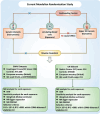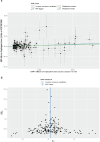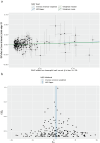Basophils may as a risk factor for upper gastrointestinal cancer: a Mendelian randomization (MR) study
- PMID: 39816393
- PMCID: PMC11735140
- DOI: 10.3332/ecancer.2024.1799
Basophils may as a risk factor for upper gastrointestinal cancer: a Mendelian randomization (MR) study
Abstract
Objective: Upper gastrointestinal (UGI) cancers, including esophageal (EC) and gastric (GC) cancers, pose a significant global health challenge. Previous studies have indicated a fundamental correlation between basophil count and the risk of UGI cancer. However, confirming a causal relationship demands further investigation. Mendelian randomization (MR) provides a critical method for evaluating the possible causal connections between peripheral circulating blood cells (PCBCs) and UGI cancer.
Method: Our study comprehensively employed a two-sample MR analysis. We used publicly available genetic data to survey the causal association between PCBC and UGI cancer. We used inverse variance weighting and weighted median for MR analyses and sensitivity analyses to assess heterogeneity and pleiotropy.
Results: In terms of the association between PCBCs and UGI cancer, we found that basophils count (EC: OR = 1.416, 95% CI = 1.125-1.783, p = 0.003; GC: OR = 1.623, 95% CI = 1.052-2.505, p = 0.029) were all strongly correlated with both EC and GC. Interestingly, Basophil count was a risk factor for both EC and GC. However, no significant correlations were seen between eosinophil, monocyte, lymphocyte or white blood cell count and UGI cancer.
Conclusion: The findings of this research corroborate the idea that basophils might serve as a fundamental risk factor for UGI cancer. Further exploration of the underlying mechanisms driving this relationship could provide crucial understanding helpful in creating prospective preventive and treatment methods for UGI cancer.
Keywords: Mendelian randomization (MR); esophageal cancer; gastric cancer; genome wide association study (GWAS); peripheral circulating blood cells.
© the authors; licensee ecancermedicalscience.
Conflict of interest statement
No competing interests.
Figures





References
-
- Ferro M, Di Lorenzo G, Vartolomei MD, et al. Absolute basophil count is associated with time to recurrence in patients with high grade T1 bladder cancer receiving bacillus Calmette-Guérin after transurethral resection of the bladder tumor. World J Urol. 2020;38:143–150. doi: 10.1007/s00345-019-02754-2. - DOI - PubMed
LinkOut - more resources
Full Text Sources
Miscellaneous
